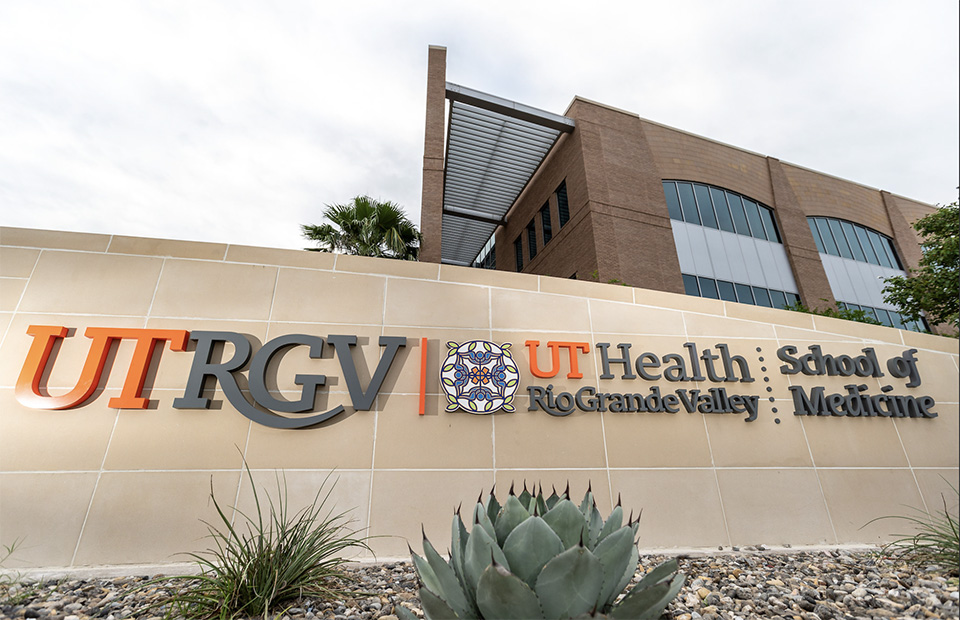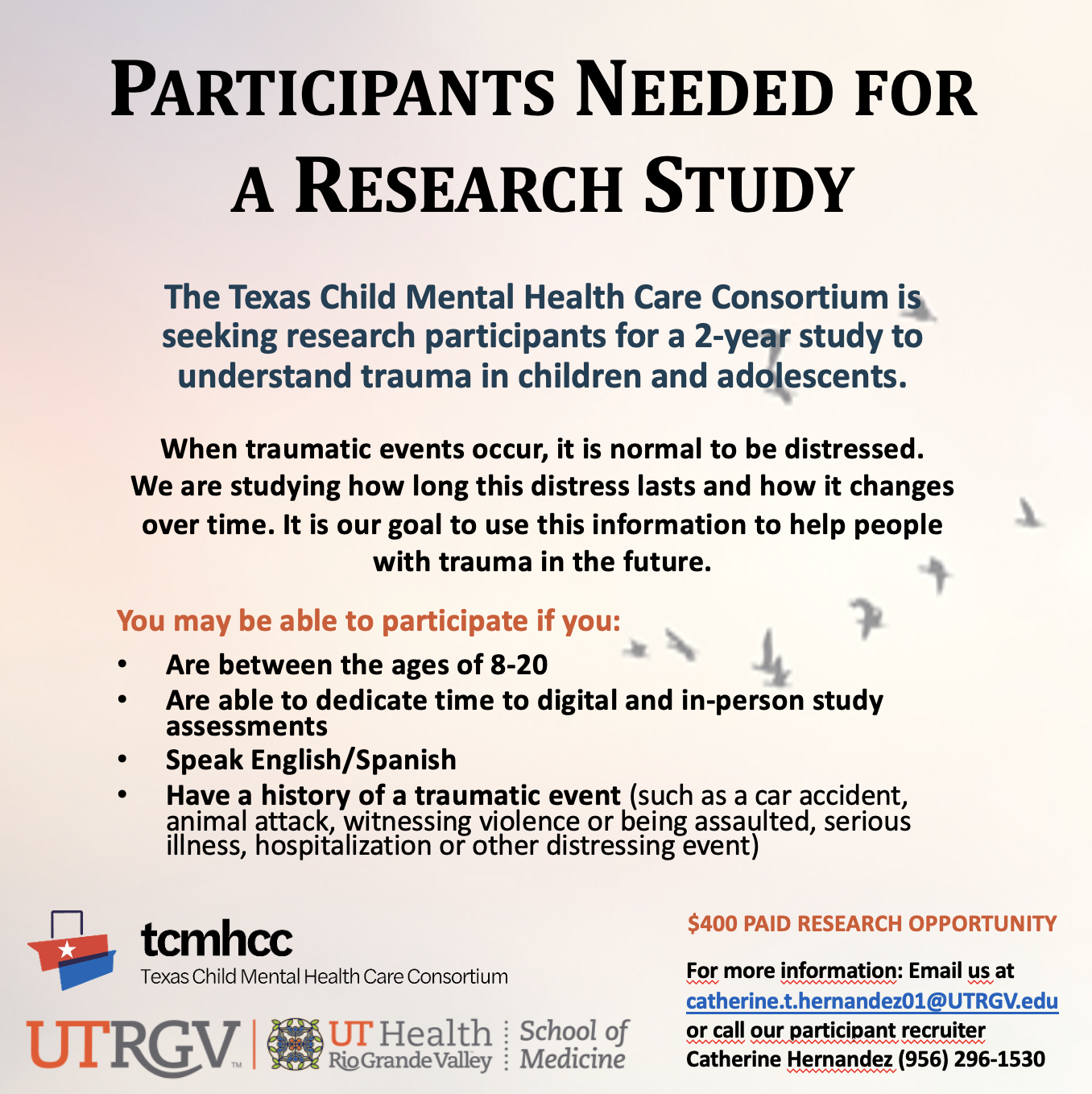
UTRGV School of Medicine Building in Edinburg. (UTRGV Photo by David Pike)
News Release | Health, Community

UTRGV School of Medicine Building in Edinburg. (UTRGV Photo by David Pike)
Thursday, May 4, 2023
Community, Research
By Karen Villarreal
RIO GRANDE VALLEY, TEXAS – MAY 4, 2023 – UTRGV School of Medicine researchers have joined psychologists and psychiatrists at learning institutions across Texas to hear what young people have to say about their experiences with depression or trauma.
Their analysis of what the youths say will help inform state leaders of evidence-based guidance for treatment and legislative funding recommendations for services.
Dr. Cynthia Garza, principal investigator for the UTRGV site of the study, said the team is still recruiting youths in the Rio Grande Valley who are in treatment for depression, experiencing suicidal ideation, or who have experienced a traumatic event. It is key that the community’s needs are represented when they make their recommendations, she said.
“Being part of that recommendation to the state is a chance to give the children, teens and families of our region a voice,” Garza said. “We are in a historic time in mental healthcare.”

Researchers hope that by working together, they can understand the individual psycho-social, economic and environmental elements behind childhood depression and trauma, along with any systemic factors contributing to this growing problem.
TEXAS YOUTH IN CRISIS
CLINICALLY INFORMED RECOMMENDATIONS
Texas has funded two research hubs to analyze the rising mental health issues: the Youth Depression and Suicide Research Network (YDSRN) and the Childhood Trauma Research Network (CTRN), both under the umbrella of the Texas Child Mental Health Consortium (TCMHC).
Garza, assistant professor of medicine in the Department of Psychiatry at UTRGV School of Medicine, is working on studies for both research hubs – speaking to young people from across the Rio Grande Valley who have experienced a traumatic event or cope with depression and/or suicidal thoughts and who are willing to talk about it.
“We are asking people to tell us hard stories,” Garza said.
By analyzing these firsthand accounts, researchers statewide are seeking to determine effective therapy modalities, medication, lengths of treatment – and what stressors interfere with recovery – to inform the state’s psychiatrists, counselors, pediatricians and family practice doctors.
“And, this data can back up budget recommendations to address systematic issues at the state level,” she said.
For example, if researchers find that many participants see significant improvement in their symptoms after six sessions of counseling, that can be set as a baseline recommendation for treatment.
“Or, if we find that many children are experiencing school-related stress, that could call for the Legislature to fund more mental healthcare professionals in schools,” said Garza, who has a caseload of approximately 40 through the TCMHC’s Texas Child Health Access Through Telemedicine (TCHATT) program.
“TCHATT is a bridge-of-care service that offers brief mental health services. We connect participants to ongoing care and resources when needed,” she said, and that includes educational videos for families. “The study’s findings could further expand the growing program.”
CRITICAL INPUT
The YDSRN study is carried out through study visit interviews with the children (between the ages of 8 and 20) and their parents. After a thorough initial interview to identify comorbid mental health issues, treatment history and social-economic mental health contributors, follow-up visits allow the UTRGV team to identify newly developing symptoms or improvement of symptoms between visits.
With consent, the child’s psychiatrist or pediatrician – whom the youths might see once every few months – can review their symptoms reported to YDSRN, which can prompt treatment intervention, such as psychotherapy or medication.
The trauma study, which is recruiting individuals between the ages of 8 and 20, does not require the individual to be in treatment.
“Unfortunately, many participants don’t seek treatment,” she said. “But it does allow us to compare what symptoms look like when in and out of counseling, and to identify resilience factors.”
As the YDSRN and CTRN studies enter their third year, Garza said, they have published papers on early findings of their participant group. This establishes generalized characteristics of the sample’s ethnic identity, acculturation stress, healthcare experiences and school experiences.
The Rio Grande Valley participant group is predominantly Hispanic and female – all underrepresented groups in research.
Garza said she is motivated to research what treatments are effective for underrepresented groups.
“If current practices don’t demonstrate that they work for us, let’s tailor them to meet our needs and validate that,” she said.

ABOUT UTRGV
The University of Texas Rio Grande Valley (UTRGV) was created by the Texas Legislature in 2013 as the first major public university of the 21st century in Texas. This transformative initiative provided the opportunity to expand educational opportunities in the Rio Grande Valley, including a new School of Medicine and a School of Podiatry, and made it possible for residents of the region to benefit from the Permanent University Fund – a public endowment contributing support to the University of Texas System and other institutions.
UTRGV has campuses and off-campus research and teaching sites throughout the Rio Grande Valley including Brownsville (formerly The University of Texas at Brownsville campus), Edinburg (formerly The University of Texas-Pan American campus), Harlingen, Weslaco, McAllen, Port Isabel, Rio Grande City and South Padre Island. UTRGV, a comprehensive academic institution, enrolled its first class in the fall of 2015; the School of Medicine welcomed its first class in the summer of 2016, and the School of Podiatric Medicine in the fall of 2022.